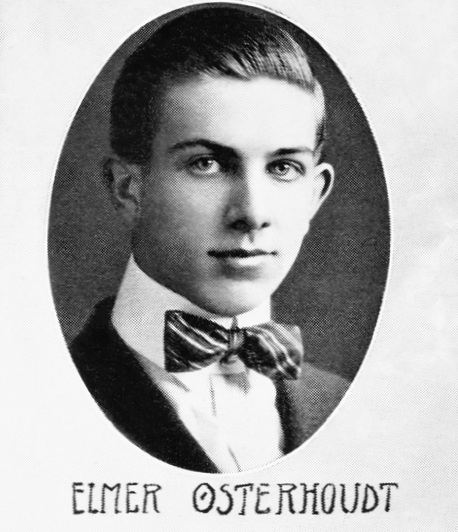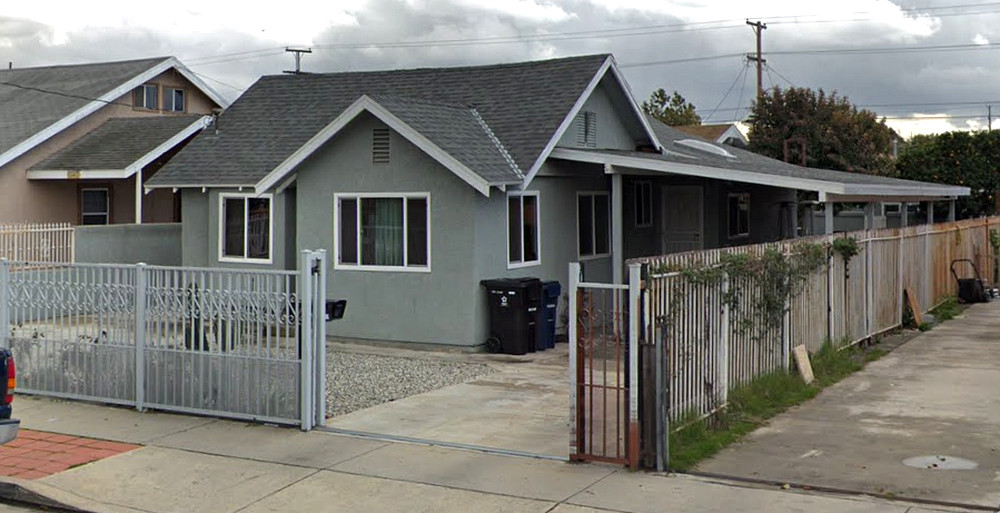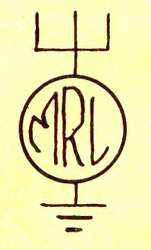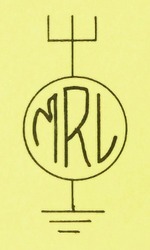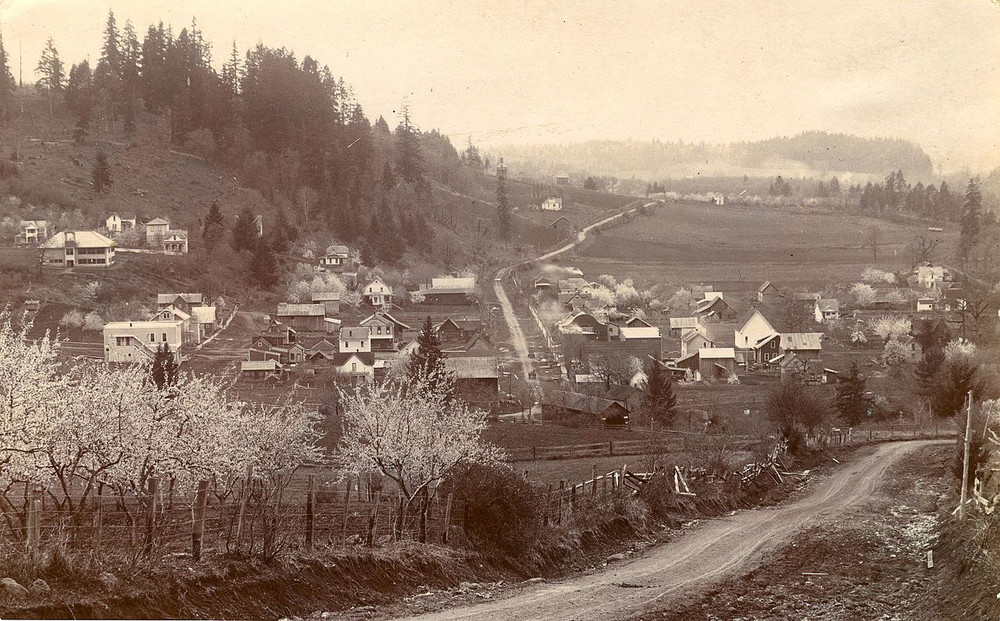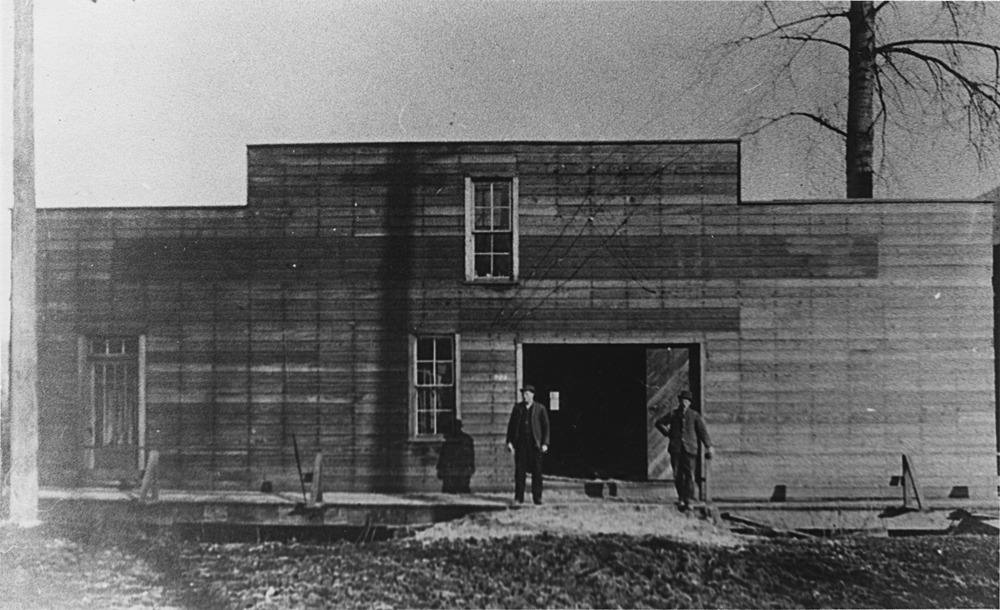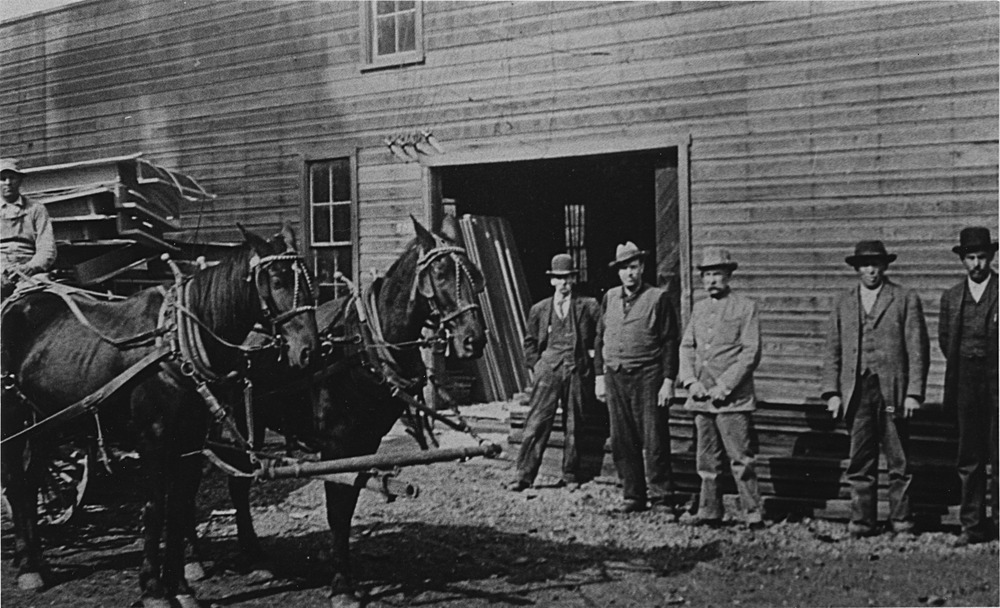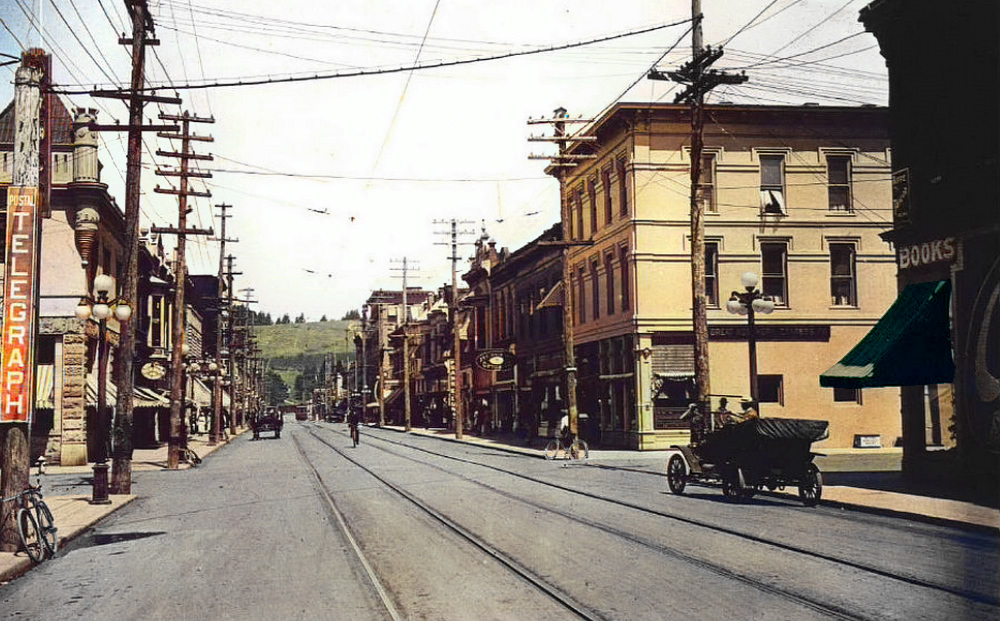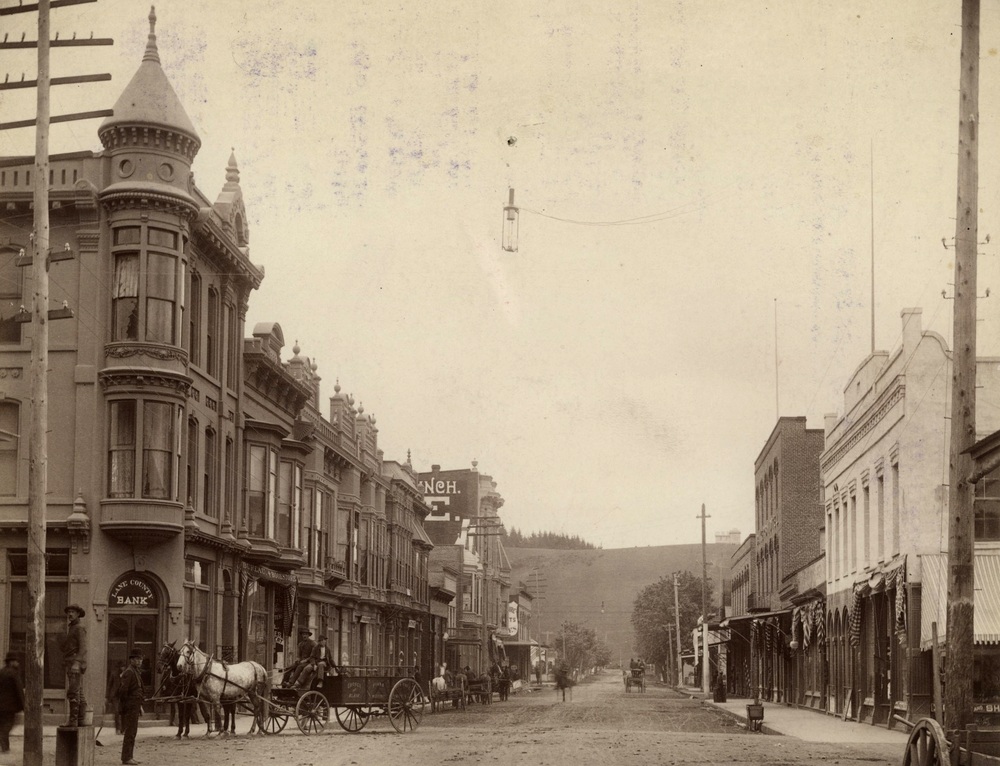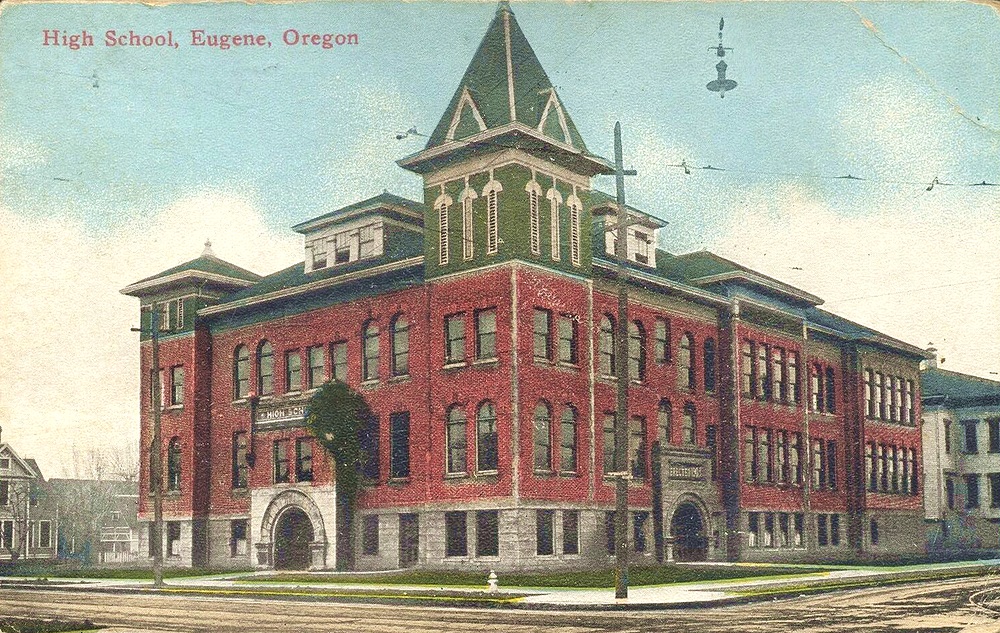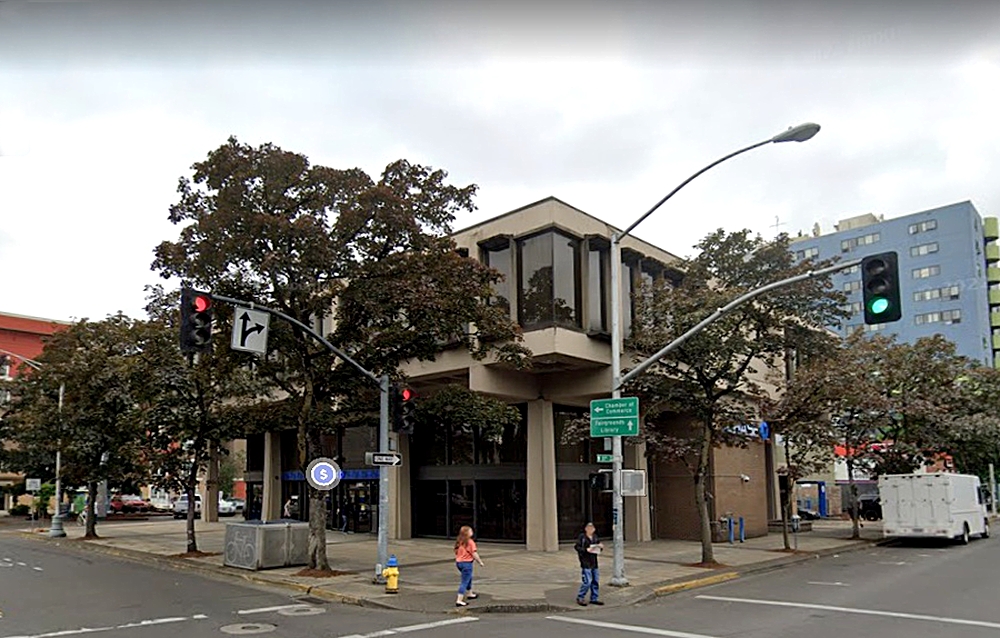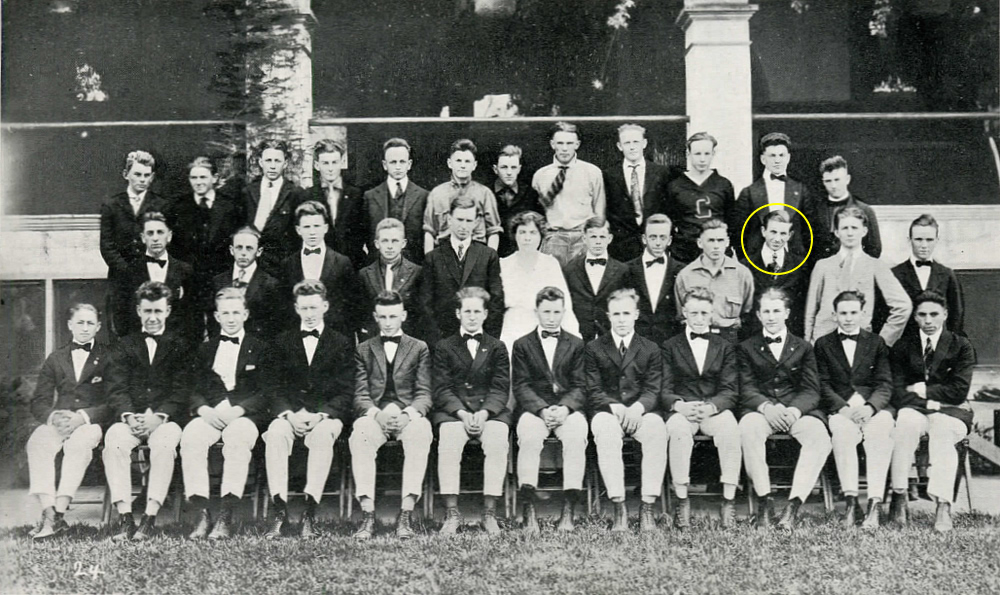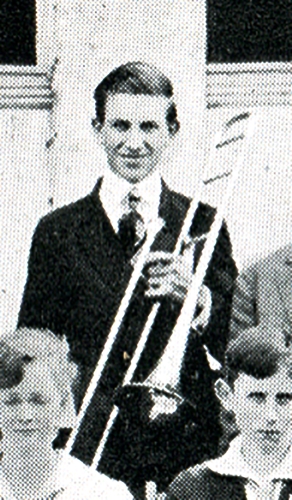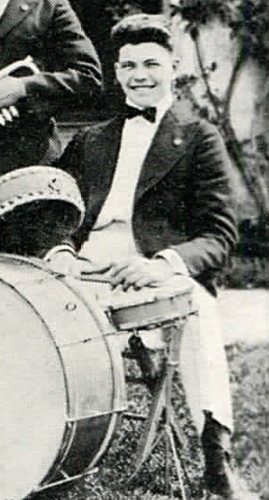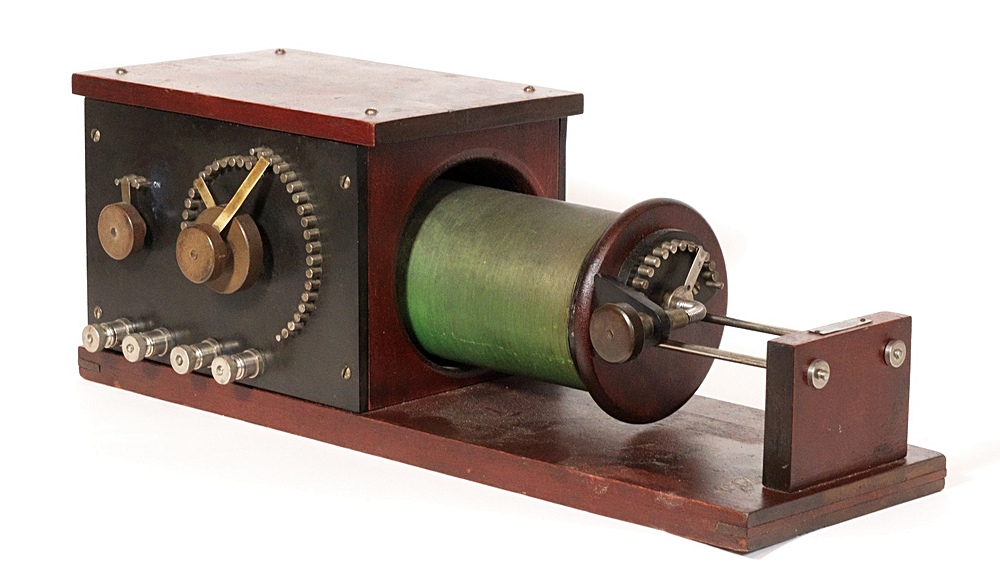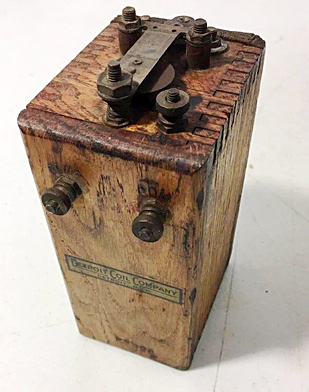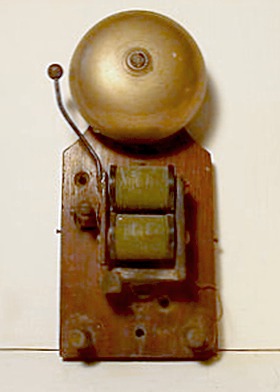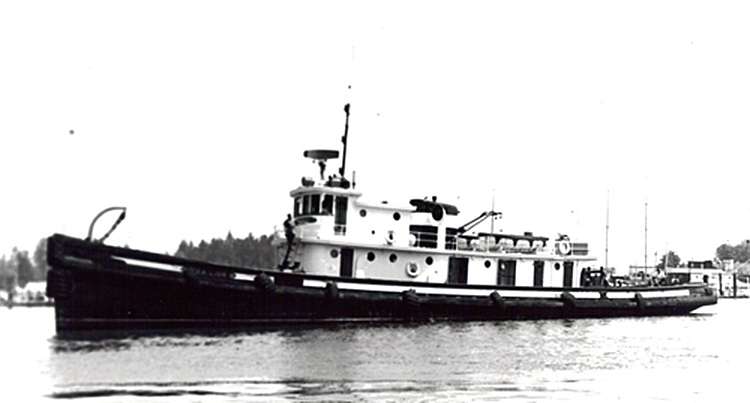|
|
|
|
|
|
|
|
|
| |
|
Photo from 1918 Compton Union
High School yearbook |
Photo thanks to Victor Rodriguez |
|
|
|
One day in 1915,
after reading a 10¢ booklet*
concerning a new technology called "wireless telegraphy," a 16
year old boy named Elmer G. Osterhoudt began the
construction of a crystal radio. He was attempting to
receive the signals that were said to be invisibly traveling
through space, undetectable by human senses.
He wound a beautiful coil made of 200 turns of 28 gauge
cotton covered wire on a piece of broom handle. Then he
painted it with white lead paint which he had invented
himself. Connecting the coil to a galena crystal, headphones
and antenna, he listened in vain for the wireless signals.
He soon came to the realization that his radio didn't work.
The lead in the paint had ruined the coil. The radio was
stone dead; he couldn't get as much as a click out of the
headphones.
Elmer had a neighbor who was also interested in Wireless and
who was also named Elmer.**
This Elmer also had made a radio that didn't work. He came
by with his radio because Elmer Osterhoudt "knew all about
radio." Elmer put the other Elmer's non-painted coil into
his set and in came a powerful rotary spark signal from
station 6JG! ***
The magic of this single event influenced the entire
remainder of his life. A first-hand account can be found on
Page 2 of "How To Make Coils" by Elmer Osterhoudt, written
in 1957.
Link
* In HB-5 "CRYSTAL SET
CONSTRUCTION" Elmer names two magazines, "QST" and "The
Electrical Experimenter." In April of 1915 the price of
"The Electrical Experimenter" went from 5¢ to 10¢, which narrows down the volume
that Elmer actually read. The July issue, on page 109, shows
a simple wireless receiving set. There is no coil data, but
the illustration resembles what Elmer described above. Page
109 also has an article on how to blow up a toy boat using
homemade wireless apparatus and a simple mine filled with
gun powder.
Link
QST was also 10¢
but there were no "how to" articles published in QST at the
time. In any case, it doesn't seem that Elmer put down the
magazine and spontaneously assembled a crystal set. He
already had the wire, the detector, and a pair of
headphones.
**
After searching Los Angeles property records and the US
census for any neighboring household that had a boy named
Elmer of the appropriate age, fellow MRL fan Victor
Rodriguez has determined that this person is Elmer Stevens.
He appears in the Compton Union High School yearbook with
Elmer Osterhoudt.
Link
The two Elmer's were in the high school band
and school orchestra together, but their friendship is
unknown. Elmer referred to him as "a neighbor boy" in his
account.
*** There was indeed an amateur with the call
sign 6JG. The 1916 edition of "Radio Stations of the United
States," issued by the Department of Commerce, lists him as
James A. Homand of 1423 McKinley Street in Los Angeles,
California. This address is about three miles from where
Elmer lived. |
|
|
|
|
|
In 1917 Elmer Osterhoudt and his family
lived at this address at 1936 East 77th Street in Los
Angeles, CA. The 100+ year old house, built in 1908, lies
under the additions and modern exterior of this building.
Elmer obtained
the amateur call sign 6NW in 1917. Prior to that he used the
made-up call of "EO." While living at 77th and Crockett (the house
in the photo above), he had erected a 55 foot antenna mast
made of all sorts of 2x4s, 2x3s and pairs of 1x2s. It had a
dozen guy wires made of bailing wire. On top of the mast was
a four wire antenna, each wire separated by 30 inches. (He
didn't say what the other end was connected to.) It was up
for about a year when his father decided to move, so he had
to take it down. That's when he noticed the bailing wire had
almost rusted through. It would have fallen down by itself
in another month, and would have either hit the house or
have fallen into the street!
If that was the case, we're probably looking at the exact
spot where the mast was located.
It was just as well. On April 6, 1917, due to the war, it
became illegal for a private citizen to own a working
transmitter or receiver. It was considered an act of treason
to operate a transmitter, and no excuse would be made if
they were operated by "boys." In addition, the Department of
Commerce directed that "the antennae and all aerial wires be
lowered to the ground." It's almost hilarious that Elmer's
antenna would have complied of its own accord.
On May 1, 1917, the Osterhoudt's moved to 241 E. Truslow
Avenue in Fullerton, California. Elmer was interested in
entomology and biology, and without being able to use his
radio equipment he pursued these fields instead. He was a
member of the Lorquin Natural History Club, he corresponded
with professional entomologists, and placed ads in the
Lepidoptera, a Boston publication, to trade insects and
butterflies from the east coast. He raised the
butterflies himself.
By 1918 the
Osterhoudt's were back in Los Angeles at the same
address of 1936 E. 77th Street, but would eventually move to 8011 Crockett
Boulevard, a few blocks away.
This might have been the end of the story of Elmer
Osterhoudt's interest in radio, just another boyhood hobby
set aside. However, the young Elmer was very resourceful.
Since it was illegal for a civilian to own radio apparatus,
he joined the Navy and became a Radio Mechanic!
|
|
|
|
| Elmer may have
read this article in the July 1917 issue of QST. This issue
specified it was the Navy who needed wireless operators, and posted the pay rates for radio electricians, from $41
dollars a month for Third Class to $61 dollars a month for
First Class. It stated that Uncle Sam expected every
wireless operator to do his duty and enlist. A free cot, food, and a uniform were included,
of course. |
|
|
|
|
During his lifetime Elmer Osterhoudt would (in all
probability) hand-wind more coils and design and sell more
crystal radios than anyone who has ever lived. He outlasted
all his competitors in the mail order crystal radio
business. He, along with his wife Mabel, ran a mail order
company named "Modern Radio Laboratories" for 55
years.
He sold thousands of kits, coils, crystals and all parts
related to crystal radios, many of which he made himself. He
published the MRL catalog, the MRL "Radio Flyer," MRL handbooks,
MRL "Detail
Prints" and a quarterly publication called "Radio Builder
and Hobbyist." He printed them himself, at first with a
mimeograph machine and later on a lithograph printer.
Everything needed for a radio could be found in his catalog;
coils, capacitors, headphones, switches, jacks, binding
posts, sockets, crystal stands, knobs, batteries, wire, all
sorts of hardware and even vacuum tubes and transistors. He
manufactured over FIFTY-FIVE types of coils, all made by
hand!
|
|
|
|
|
The MRL logo was hand drawn by Elmer, and almost
every one is different. "First use in commerce" of Elmer's
trademarks is listed as December 15, 1932. Today, these
trademarks are owned by Paul Luther Nelson, current owner of Modern
Radio Laboratories®, who registered the
logos to himself in 1999. |
|
|
|
|
There is little
information about Elmer available but we can glean some
details from city directories, census records, birth and
death certificates, advertisements, and his literature - and
he wrote a lot of literature. He also included a hand
written note with each order, some of which have survived.
His company, Modern Radio Laboratories, was
established in 1932. It says so, right at the top of the
"EXPERIMENTER'S CATALOG." Oddly enough, Elmer rarely used
the entire name in his handbooks and other publications. On the catalog it is shortened to "MODERN RADIO LABS" and
elsewhere simply to "MRL." Some of his magazine
advertisements listed the company as "Modern Radiolabs" but
later it was shortened to "Laboratories," since these ads
were charged by the number of words.
Every one of his handbooks has this list of accomplishments
printed inside the front cover: |
|
"WITH RADIO SINCE 1915." including:
RADIO Operator, R.C.A. Marine Service.
Radio Mechanic, Maximum, USN.
Technician, Electrical Products Corporation.
Southern California Edison Company.
Majestic Electrical Products.
U.S. Motor Company
Manchester Radio Electric Shop
Modern Radio Laboratories
Amateur and Radio Service
6NW (1919)
|
|
|
|
|
|
|
Scotts Mills, Oregon. Photo taken in 1912 by
James Eaton.
(Click for full size - will open in
new tab.)
|
|
|
|
Elmer was born in the Scotts Mills Precinct of
Oregon on October 6, 1899, the son of Wilbert and
Minnie Osterhoudt. Wilbert (also known as William)
was a farmer, carpenter, and a cabinet and furniture
maker.
According to the 1900 census, the family lived on the farm of Charles Higby
Osterhoudt, Wilbert's father. Wilbert's mother,
Elizabeth Woodruff, had passed away in 1896. Also on the farm were
two of Wilbert's brothers, Henry and John. Cyril
Wilbert Osterhoudt, Elmer's brother, was born on
April 17, 1901.
Note: Elmer's
1942 draft card states that he was born in Butte Creek,
Oregon. Butte Creek was incorporated into Scotts
Mills in 1916, but Elmer was apparently born on his
grandfather's farm and not in the town itself. A mortgage document from June 7, 1887
states this farm is where the actual Butte Creek
intersects the "county road leading to Silverton."
The county road is today route 213, also known as
Cascade Highway. The property line ran down the the
road and
followed Butte Creek for a short distance, and is about
two miles north-west of
Scotts Mills. Adjoining the southern end of the
Osterhoudt farm was a farm owned by Cornelius
Woodruff, Elizabeth Osterhoudt's father. Also, 10 acres of the
Osterhoudt farm were owned by Elizabeth's sister,
Sarah Coffin. A 1929 map of the Butte Creek area
shows a plot of the Osterhoudt farm still owned by
Elmer's aunt, Luella Dicken. (See
this.)
The population of Scotts Mills at the time was about
100. There is no birth certificate for Elmer, as
none was needed in 1899. Cyril obtained a "delayed"
birth certificate in 1942. It states that he was
born in Silverton, Marion, Oregon, about 5 miles
from Scotts Mills. In fact, the current address
of the farm location is Silverton, Oregon, though it
is closer to Scotts Mills. From this we my surmise that
Cyril was also born on the Osterhoudt farm. Charles, Elizabeth and Minnie are
buried in Miller Cemetery, which sits almost exactly
between Silverton and Scotts Mills. Today, most of the
area is still open farmland.
Sometime around 1902, Charles
Osterhoudt, Wilbert, Minnie, Elmer, John and Henry
left the farm and moved
to Spokane, Washington. Cyril was probably with
them but ended up living with Wilbert's sister Nellie McConnell and her
husband Charles. The McConnell farm was
right outside of Scotts Mills.
|
Entry
from the 1903 Spokane, Washington City Directory. The house
in the listing, built in 1889, still exists. |
From Spokane
they moved to Yakama City. Charles died there in
April of 1903. Minnie Osterhoudt died of typhoid
fever in September 1903 at the age of 27. A lone
newspaper article hints that Elmer and Cyril had a
three month old brother named Clarence who died two
weeks after their mother died (see page 12). Wilbert, Henry, John,
and four year old Elmer moved to
Vancouver,
Washington. From there they moved to Eugene,
Oregon. (It may have been around this time that Cyril
was sent to live with the
McConnell's. All we have to go on is the 1910 census.)
On July 27, 1904, John
Osterhoudt married a girl named Lillie S. Shields in
Vancouver Washington. They lived on a 160 acre
homestead near Enterprise,
Oregon. John
listed himself as a farmer in the 1910 census.
Elmer wrote in MRL Data Sheets Vol. 6 that
his father owned a planing mill in Eugene. (A
planing mill takes boards from a saw mill and turns
them into finished lumber.) Actually, Wilbert didn't
own the mill outright, he had a partner named Jim
Smith. The company name was "J H Smith & Co,"
according to the city directory. The mill was
a few blocks from the
Willamette River near Skinners Butte, where the mill
race met Eighth Avenue.
Henry Osterhoudt also worked at the mill.
The 1910 census shows that Wilbert and Elmer lived
at
205 8th Avenue in Eugene. This was the actual
address of the planing mill, named "Eighth Avenue Planing Mill."
The mill was also known as "Eighth Street Planing Mill."
Wilbert's brother Henry, his wife Fanny and
their son Darrel rented a house a few blocks away
at 316 East
15th Street.
In 1912, John, Lillie and their children moved from Enterprise to
593 8th Avenue in Eugene. John then worked at the
mill, along with Wilbert and Henry.
|
|
Entry from
the 1911 Eugene City Directory.
Henry has moved from East 15th Street to
West 10th Street. The street names change
from
East to West at Willamette Street, and the
new address places his residence much closer
to the mill. |
|
Cyril was
reunited with his father and Elmer sometime between
1910 and 1912.
An article in
the Eugene Guardian states that Wilbert had
married Lela May Smith in 1911, and the 1914 City
Directory shows they lived at 656 E. 8th Avenue.
However, it seems Wilbert was abusive, and he
encouraged both Elmer and Cyril to act unkindly
towards her. Lela May went into hiding and filed for divorce in June of 1914.
The
divorce was granted on August 18, 1914.
|
Entry
from the 1914 Eugene City Directory. |
|
|
Was Lela May Smith the daughter of
James H. Smith, Wilbert's partner? After some
investigating, it has been determined she was not. There was a Lela May
Smith in Eugene who was the daughter of James Smith, but it
was a different James Smith. He was James L. Smith, a farmer who
died in 1907. This other Lela May
Smith married Clark H. Hileman in 1903 and was still married
to him when she died in 1933.
Lela May Smith Osterhoudt's mother's name was Nancy.
The 1920 census states that James H. Smith, 67, of 205 8th
Street in Eugene City, was married to Jessie D. Smith, 48
(not Nancy). His occupation was "Carpenter in a planing
mill." |
|
|
Wilbert
Osterhoudt and Jim Smith at the Eighth
Avenue Planing Mill 1909.
Click for full size.
Construction of the mill began on October
10, 1908 and it opened a month later. |
|
|
|
|
| Left to
right: Jim Smith, Wilbert Osterhoudt, Mr.
Basinette, Henry Osterhoudt, John Edwin
Osterhoudt. Click for
full size. |
|
Fun facts:
Wilbert was 5'8" tall. Henry was 5'9" and
John was 5'8". (Information from a
census document from Marion County, Oregon,
1895) When this picture was taken Wilbert
was 39 years old, Henry was 44 and John was
34. |
|
| |
The 1910 census shows
that Henry Osterhoudt, his wife Fannie (or
Fanny) and his son Darrel lived at 316 East
15th Street in Eugene.
Darrel was born in
1903 in Cottage Grove, Oregon, about 21
miles south of Eugene. He would
have been a few years younger than Elmer and
Cyril. This is interesting because the 1903
Spokane, Washington city
directory shows Henry Osterhoudt was in
Spokane with his father and brothers that year. 1903 was also the year
that their father Charles and Elmer's
mother Minnie died in Yakama City.
Fanny's maiden name was Woodruff. Henry and
Fanny were distantly related before they
were married. Wilbert, John and Henry's mother's maiden name
was Betsy Woodruff. Henry's grandfather on his
mother's side, Cornelius
Woodruff, and Fanny's grandfather Brock
Woodruff were brothers. Henry and Fanny
both had the same great grandfather, Asa
Woodruff.
The only other information we
have about Henry is that he died in 1920 at
the age of 56. At that time he
was a farmer who owned a farm in Hopewell,
Oregon, about 90 miles from Eugene but only
about 20 miles from Scotts Mills.
In 1922 Fanny moved to Portland with
Darrel, who graduated Benson Polytechnic
High School in 1924. Sometime after 1927
Darrel bought a tiny house at 3381 S.
Francis Street, and he and Fanny lived in it
for the rest of their lives. A voter
registration card shows that Hazel May
Osterhoudt, daughter of John and Lillie,
lived with them in 1936. Hazel
married Eldee Buhite in 1939 and they moved
to Washington County, outside of Portland.
(Their son, Edwin John Buhite, was a member
of The Cat Whisker Society in 1990
and mentioned his cousin Elmer Osterhoudt in
one of their newsletters.) Also living
at the Francis Street address in the 1940s was Hazel's
brother, Merrill Osterhoudt. Merrill
joined the Navy and spent 20 months in the
Pacific during WWII.
Fanny died in December of 1967 at the age of
92. Darrel died 11 months later at the age
of 65. He was a foreman working for the
Portland City Parks Department and had just
retired that June. He had been there since
1932, the year Elmer Osterhoudt created
Modern Radio Laboratories.
Henry, Fanny and Darrel are all buried in
Hopewell Cemetery. Each has the same type of
tombstone, and they are
lined up in a row.
Hopewell is located where two roads
intersect in an area of ranches, farms and a
winery. It has two churches, a cemetery, a
little store that sells coffee, and a sign
that says, "Thank You For Visiting Hopewell."
It's
considered an "unincorporated community"
and there are very few houses in the area.
Who would have been there in 1967 and 1968
to bring Fanny and Darrel back from Portland to be buried next to Henry
Osterhoudt? Who in Hopewell would even
remember them? If Fanny and Darrel lived in
Portland for 45 years or so, why aren't they
buried in Portland?
I can offer a theory: Fanny had in her will
that she wanted to be buried next to Henry.
Darrel would have taken care of this if he
was able. Then Darrel died, and since he had
no wife or children it may have been Elmer's
cousins, the children of John and Lilly, who
laid him to rest with his parents. Some of
them, including Hazel May, still lived in Oregon and Raymond
Osterhoudt lived in Portland. |
| |
|
| |
In 1912, when Elmer was 13 years old and living in
Eugene, he traded in three empty beer bottles for
the deposit and bought a 10¢ book named "The Star
Toymaker." Using the plans from this book, Elmer and
Cyril built a tin talking machine, bird houses,
motors, waterwheels, stilts, telegraph sounders,
electric bells and dry cells. They would also go to
garages and acquire discarded dry cells from Model T
Fords to power their projects. At one time they had
about 100 of them connected together in series for
"a sparking good time." When the cells became
depleted they figured out how to chemically
rejuvenate them using a saturated solution of Sal
Ammoniac.
|
|
8th and Willamette Street in 1915, a few
blocks from the mill. In the background is
Skinner Butte. On the right is a
bookstore. It was probably the closest
bookstore to the mill and it's possible Elmer purchased
The Star Toymaker there in 1912. It seems he also
purchased Popular Mechanics.
(Colorized B&W photo.)
|
They also used the cells to set off their cannon,
which was made of a foot long pipe 1" in diameter,
mounted on a 2" x 6" board. One end was closed off
with a big bolt and had a slot sawed into it to hold
the end of a lamp cord. They charged it with Potash
and Sulfur and sent an electric current through the
lamp cord. According to Elmer, they once stuck the
handle from an old umbrella into it, and it was
blown out with enough force to drive it through a
wooden box.
Handbook 8, Radio Kinks and Quips, contains
the following three sentences: "At home, my brother
and I used to drive our poor Dad nuts. We had an
Edison Cylinder record phonograph. We used to
reverse the belt and run it backwards."
Accounts of how to make a canon out of a 1" gas
pipe, how to rejuvenate dry cells with Sal Ammoniac,
how to reverse the belt on an Edison phonograph, and
even how to acquire depleted batteries from
automobile garages can be found in Popular
Mechanics magazines that were published prior to
1912, so it seems Elmer may have been reading
Popular Mechanics in addition to The Star Toy
Maker.
According to Elmer, they sometimes threw their old
dry cells out their 2nd story window at their dogs
below when the dogs were "celebrating." What is
interesting about this sentence is that the
Osterhoudt's had dogs at the mill. Elmer and Cyril built "grass
sleds" and used them to sled down Skinners Butte,
which rises 250 feet above the surrounding city.
Skinners Butte is still a recreation spot today.
Near the base of the Butte was a mill race
connecting to the Willamette River. The mill race
crossed 8th Avenue at the location of Wilbert
Osterhoudt's mill at 205 8th Avenue. (There were several planing mills
at the time in the immediate area.) Skinners
Butte was only a few blocks away from the mill. On top of the
butte were the charred ruins of an observatory
which had been dynamited in 1905, so it must have
been a great place for kids to explore. Also on the
butte were two reservoirs, the larger one holding 2
million gallons of water for use by the fire
department.
|
 |
The observatory atop Skinner Butte before it was dynamited.
A grass sled from The Star Toy
Maker. Elmer
and Cyril would have had plenty of scrap wood
from the planing mill.
A copy of the book is on Page 13.
By the way, Elmer
still had the book in 1966.
Downtown
Eugene, Oregon in 1903. Skinners Butte rises in the
background. On top of the butte can be seen the
observatory. Elmer and Cyril probably walked down
this very street. None of these buildings are still
standing as they've been replaced with modern
structures. The mill race has been filled in. The
current address of the planing mill site is 8th and
Mill Streets, which is currently occupied by the
Wayne Lyman Morse United States Courthouse.
Eugene was home to the University of Oregon. See
this
map.
The Osterhoudt planing mill is at the bottom of
Plate 16 of the 1912 Sanborn Fire Insurance maps.
Link
Plate 16 can also be viewed
here.
On August 14, 1915, one year after his divorce from
Lela May, Elmer's father married Alice Elsie
Shields, the sister of his brother John's wife,
Lillie. By this time Wilbert and Alice had a
daughter named Wilda Frances Osterhoudt. Lela May
had asked for 1/3 of Wilbert's property and $25 a
month alimony during the divorce. The Lane County
History Museum states that the J. H. Smith & Co mill
stopped operating in 1914, the year the Osterhoudt's
were divorced. It's impossible to know the exact
chain of events, but Wilbert and Alice left Eugene,
taking Elmer, Cyril and Wilda with them. They were
married in Santa Ana California, and would spend the
rest of their lives in Los Angeles.
Elmer and Cyril eventually had six half-brothers and
sisters, though two sisters died young; Nora died of
Whooping Cough when she was almost 4 years old, and
Ada May died of pneumonia the day before her second
birthday. (See Page 12 for a list of siblings.)
|
|
|
|
|
|
|
|
Eugene Central Grade School (on the right as it looked in
1903) where Elmer attended grade school. According
to The Eugene Daily Guard, Elmer was one of a
handful of students who successfully
completed the eighth grade examinations in the
subjects of physiology and geography while still in
seventh grade. |
|
|
Click for full sized
postcard. |
|
|
|
|
|
Eugene High School as it appeared in 1912. Built in 1900, Elmer
attended school here. If you compare this view with
the one above you'll notice an addition has been
built on the right. It was located at Willamette
Street and West 11th Avenue, a few blocks from the
mill on 8th Street. In 1915 a new high
school was built and this building became Eugene
City Hall. Elmer didn't get a chance to attend the new
school. By the time it opened, the family was in
Santa Anna or Long Beach, California.
Today a branch of Chase Bank and a
convenience store are located on the sites of the
two schools. |
|
|
|
|
|
|
Willamette Street and West 11th Avenue,
120 years later. Only the fire hydrant remains, and it's
probably not even the same hydrant. |
|
|
|
|
|
1914 Freshman class at Eugene High School.
Photo from the yearbook. Click for original. |
|
|
|
|
|
|
|
|
Fullerton Union High School |
|
|
In 1917 the Osterhoudt's moved from Los Angeles to 241 East Truslow Avenue in
Fullerton, California. Elmer attended Fullerton Union High
School. He took biology, was interested in
entomology, and had a large collection of insects.
In a letter to the noted entomologist Fordyce Grinnel Jr, dated May 21, 1917, Elmer wrote, "On
account of having to take my wireless down when we
were at Florence* I have gone into Entomology about
as deeply as ever again." The Junior College was in
the same building as the high school, and he
befriended the teacher who taught entomology there,
Hiram Tracy. Elmer would offer advice and
encouragement to the college students in the class.
He stated they always got plenty of specimens but
did a poor job of mounting them.
* What did Elmer
mean by "when we were at Florence?" The area where
the Osterhoudt's lived at 1936 E 77th Avenue is just
outside of the Los Angeles city limits and is known as
"Florence" or "Florence-Graham." |
|
|
|
|
|
| Of the twenty
members allowed in the Lorquin Natural History Club
in 1916, Elmer was number 14. Though the membership
was limited to twenty, there were many "Associate
Members." The club was organized in 1913 by Fordyce
Grinnell Jr. and meetings were held on the first
Friday of every month. In 1917 the name was changed
to the Lorquin Entomological Club. It is
still active today as the Lorquin Entomological
Society.
LINK |
|
|
|
|
|
|
Compton Union High School. Photo taken in 1903. The school
was six miles from the Osterhoudt residence.
|
| The
Osterhoudt's moved from Fullerton back to 1936 E. 77th Street in Los Angeles. Elmer
graduated from Compton Union High School in June of
1918. About 12% of the US population had a high
school diploma in 1918. |
|
|
|
|
|
|
|
Compton Union High School class of 1918. |
|
|
|
|
|
Elmer Osterhoudt. |
|
|
|
|
|
Elmer
played "First Trombone" in the school orchestra and
the band. (First Trombone is the lead trombonist, requiring a strong player who can handle
high notes and intricate passages.) Also in the orchestra was Elmer Stevens
(right), who played drums.
We believe Elmer Stevens was the "neighbor boy" who
brought his non-working crystal set to Elmer
Osterhoudt in 1915.
|
|
|
-- Click on the photos above for the complete orchestra
or band group photo. -- |
|
|
|
|
|
|
The Los Angeles 1916 Long Beach City directory lists
W A Osterhoudt as a woodworker at Jones Sash
and Door Company, located at 1101 West Broadway. The
"W A" would be William Arthur. Unfortunately it
doesn't list his address, but the 1915 directory
lists an Alice Shields at 922 W. 6th Street, not far
from the Jones Sash & Door address. Neither of these
addresses exist today, and we don't know if the
listing is the correct Alice Shields, since her name
would have changed to Osterhoudt in August of 1915.
MRL Mystery: The Osterhoudt's lived at 657 8th Ave in
Eugene, Oregon. After they left for California a woman named Olga Jones lived at
that address, while Wilbert worked for the Jones Sash and Door Company in Long
Beach. Is this just a coincidence due to a common name, or did Olga have some
family connection with Jones Sash and Door Company?
In the preface in his handbooks, Elmer wrote that he
was a technician at "Electrical Products Company."
This was a company in Long Beach founded in 1912
that made electric and neon signs. Elmer wrote that
he worked there during the war, so this would have
been sometime after 1915 but before he was in the
Navy in 1918. Since the Osterhoudt's had moved to
77th Street by 1917, it was probably in 1915 or
1916.
| Entry from the 1913
Los Angeles City Directory. This address
is in the Long Beach area. |
|
|
|
|
|
|
|
|
|
|
In 1918, Elmer worked as a laborer at Southern Board
and Paper Mills, now known as PABCO, located at
Vernon and Santa Fe Avenues in LA. (He wrote this
himself on his draft card.) The building in the
photo above was built in 1912 and would have been
quite new when Elmer was employed there. The actual
address is 4460 Pacific Blvd. The area was known as
Vernon at the time, but is now Los Angeles. 100
years later the building is still there making paper
products.
Presently, this
building is one corner of a huge complex of
buildings, some of them very dilapidated. |
|
|
On September 12, 1918 there was a U.S. Military
draft registration (the 3rd one of the war) for men
aged 18 through 45. Prior to this third draft, the
minimum age was 21. Elmer would have fallen into the
new category. Apparently, working at PABCO didn't
suit him, because he registered on the very day the
new draft went into effect, Sept 12, 1918. He and
his brother Cyril registered at the same time, but
the Navy didn't accept Cyril till August 8, 1919. It
seems Elmer was immediately accepted, as the US
military was in desperate need of radio technicians
but had no time to train them. He was stationed at
the Alameda U.S. Naval Base. The war was over "at
the 11th hour on the 11th day of the 11th month of
1918."
Draft Card
According to Elmer, he attained the
title "Radio Mechanic, Maximum" while in the Navy.
Escaping both the war and the 1918 Spanish Flu
pandemic with his life, he was 20 years old when he
renewed his Amateur Radio license in 1919, with his
old call
sign of 6NW. (It wasn't until November of 1919 that
it became legal once again for an amateur to own a
transmitter.)
He never mentioned whether he had (or needed) a
license while in the Navy, but all radio licenses
for Amateurs had to be reissued in 1919. Since he
was at Alameda in 1919 he probably went to San
Francisco to take the test, which is a short
distance away. (If he had been back in Los Angeles he
could have taken the written test by mail as long as
he provided an affidavit that he could send and
receive ten words per minute.) Millions of men were sent home after the
war, and by examining the dates of the known details
of his life, he had not been at the Naval base for
the whole two years of his enlistment. When he left
the navy he moved back home to his family at
Crockett Boulevard in Los Angeles.
1919 was during the age of the spark gap
transmitter. Elmer's first transmitter was a spark
plug coil from a Ford automobile that was fed with
an AC doorbell transformer. The tone changed during
transmission as the points got hot! His second
transmitter, which he called his "handsome homemade
rotary spark," was fed with a 1/2 kilowatt
transformer from Sears and Roebuck. At the first
press of the key the spark jumped to the shaft of
the motor, burning it out. One can imagine the look
on his face as the rapidly spinning motor slowly
came to a stop - permanently. Later he "got a new
rotary spark gap" and "proceeded to jam up the air."
There were only a handful of operators on the air
back then, and the best distance one could get was
about 30 miles. His self-designated call letters
were "EO" till the government made amateurs get a
license because they were having "too much fun."
His receiver was a loose coupler with an Audion
vacuum tube
detector.
| A "Navy Type"
loose coupler from 1921. (It's a
"loose" coupler because the coil on
the right slides in and out of the
box, which houses a larger coil.
Taps on the large coil are connected
to the switches on the front.)
Elmer's loose coupler may have
resembled this one, but there is
no way we'll ever know. It is
just shown here as an example. |
NOTE: A spark gap transmitter basically transmitted
bursts of static. These bursts were created by
rapidly opening and closing the connection to the
low voltage side of an induction coil. Elmer used
the spark plug coil from a Ford, possibly a Model T.
(The coils were so plentiful that you can still buy
one today.) The tone was determined by how quickly
the circuit was interrupted, and this is probably
what Elmer's AC doorbell was used for. The rotary
spark transmitted a higher pitched tone, but it was
still just a controlled form of static.
When Elmer wrote that he "proceeded to jam up the
air" he wasn't kidding. These signals were so broad
that two transmitters operating within a short
distance of each other would drown everyone else out,
blanketing the airwaves with noise. By 1921 the
government refused to license any amateur who used a
spark gap transmitter which was directly connected
to an antenna.
| |
|
|
|
|
| |
A Ford Model T ignition coil from 1914 and an
antique doorbell. Of course, they wouldn't
have been antique in 1919.
|
|
| Not all Model
T coils look exactly like this one, but they
are similar. The Ford Model T had four
coils, each one in a wooden box. Millions of
Model Ts had been produced by 1919 so there
were plenty of coils to be had. There is a
vibrator mounted on the top to create a high
voltage spark, but Elmer used the doorbell
(hopefully, minus the bell). |
The "Pacific Radio News" issue of May 10, 1920 lists
Elmer as holding the radio call letters 6NW. He is
also listed in "The Consolidated Radio Call Book"
from May, 1922 and the "Citizen's Radio Call
Book" dated November 1922, with the same call sign.

Listing in the May, 1920
issue of
"The Consolidated Radio Call Book" |
According
to "Amateur Stations of the United States," in 1920
and 1921 Elmer had a 1000 watt station at 8011
Crockett Street in Los Angeles. Elmer later wrote
that the power was actually 500 watts. The June,
1922 edition of the same publication shows that
Elmer's call letters had been reassigned to J. F.
Upchurch of Vallejo, California.

|
Osterhoudt entry in the 1920
Los Angeles City Directory. |
An entry in
the Los Angeles 1920 City Directory shows an E. G.
Osterhoudt working as a laborer at Hammond Lumber
Company on Alameda Street, and the 1920 census shows
William Osterhoudt working at Blinn Lumber Company
as a carpenter. Though Hammond Lumber was about four
miles from their house on Crockett Blvd, Alameda
Street was only a few blocks away. A trolley car
could have transported Elmer up Alameda Street in less
than a half an hour.
As for his roles at Majestic Electrical Products and
U. S. Motor Company, Elmer never mentioned these in
his writings, nor did he ever mention working in a
lumber or paper mill, nor did he mention how hard it
was for a veteran to find a job after the war.
Likewise, he never mentioned that in 1920 he was a
member of the California Academy of Sciences.
The January 1920 US Census shows Elmer working for a
power company in Fresno, CA as a wireless operator.
In June of 1920, he traveled to San Francisco hoping
to land a job as a radio operator aboard a ship. He
arrived on a Saturday. By Sunday he was down to his
last $20. By Monday he was employed at Southern
California Edison Company as a wireless operator.
Apparently, he wasn't there very long.
According to Elmer's application to the Society of
Wireless Pioneers, in 1920 he was at the RCA
wireless station at Marshall, California, about 40
miles north of San Francisco. Today the station is
an historic landmark in a park-like setting, but
when Elmer was there it was surrounded by barren
coast land. He was only there a week. In July of
1920 he finally obtained a wireless operator
position aboard a ship.
Elmer relates in MRL Data Sheets Vol. 6 that
in 1920, while in San Francisco and waiting to go to
sea, he had $25 and spent $20 of it on a Kodak
camera to take a picture of a Japanese ship named
"Tenyo Maru."
The Japanese
passenger liner SS Tenyo Maru docked at
San Francisco in 1920. The photo Elmer
took may have looked very much like this
one. This photograph was taken at the
Brannan Street Wharf in San Francisco on
October 5, 1920, which places Elmer at
this very spot around the same date.
Source.
Elmer may have had an interest in this
ship because it was the first turbine
driven steamship ever to enter the port
of San Francisco. It carried Asian
immigrants to Angel Island Immigration
Station, an island in San Francisco bay.
Note: In this photo the ship is docked
between piers 34 and 36. Built in 1909,
the piers have since collapsed and have
been replaced with a public park. |
|
|
 |
|
|
|
This crop from the 1920
Compton Union High School Alumni page shows
Elmer as a 1918 graduate. He's working for
Standard Oil. (Watts, CA is where he lived
when he attended the school.) Notice that
Elmer Stevens, whom we believe is the
neighbor boy who brought his radio to Elmer
Osterhoudt in 1915 (see top of page), is a
plumber.
|
|
From 1920 to
1923 Elmer was at sea employed as a wireless radio
operator. On July 6, 1920 he was the operator aboard
the S. S. Rose City. This was a passenger ship named
after the city of Portland, Oregon.
On July 20, 1920 he was the radio operator on
"Standard Oil Barge 93."
On January 25, 1920 he served aboard a steam ship
named the J. A. Moffett, also owned by Standard Oil
of California. The J. A. Moffett, named after the
former president of Standard Oil of California, was
launched in 1914 and was the largest oil tanker in
the Pacific at the time. The radio call letters were
"WRE." Elmer made $225 a month,
which he said was "good money" (It was
$100 more than the average salary for a radio
operator on a ship at the time). On November 2, 1920,
during the Harding-Cox presidential election, the
ship was docked at Vancouver, British Columbia. At
the request of the captain, Elmer remained at the
radio in contact with station NPG in San Francisco.
When the election was over he gave the Captain the
results, then left the ship and "ran up and down
Hastings Street."
In 1921 there
was some sort of strike, which backfired. The radio
operators lost $20 a month, and on July 21, 1921
Elmer ended up on a lumber scow named the
"Willamette." Apparently, life aboard the
Willamette wasn't very pleasant due to the light
ship lurching in the waves. Elmer wrote that he got
six meals a day; "three down and three up." A good
part of his time was spent "hanging over the rail."
A Radio Service Bulletin dated October 1, 1921
lists a "Willamette" with a transmitter range of 200
miles. It had a Gray and Danielson radio. Gray and
Danielson, also known as Remler Company, was founded
in 1918 in San Francisco, so this seems to be the
correct ship. (Searching on the Internet for
"Willamette" will lead you down many strange paths.)
On August 31, 1921, Elmer was aboard the tug named
"Sea Lion." In a newspaper article published by the
Oregon Daily Emerald on November 29, 1921 it
states that radio operator Elmer G. Osterhoudt is
working aboard the tug "Sea Lion," plying up and
down the Pacific coast, where he is also studying
botany and physiology. (He was taking a
correspondence course from the University of Oregon
at the time, ergo the newspaper article.) By
September 28, 1921 he was working aboard the SS
Atlas, an oil tanker owned by Standard Oil of
California.
| |
|
|
| |
The
tugboat "Sea Lion," built in 1920 at the
Main Street Iron Works, San Francisco, CA. |
|
| |
|
|
| |
|
|
| |
|
|
| |
|
|
| |
On September 28, 1921, Elmer was in the
radio room of the SS Atlas, owned by
Standard Oil Co. of California.
(This photo was taken at the Standard Oil
facility in Ketchikan Alaska at an unknown
date.) |
|

Entry from Radio Service Bulletin, US Department of
Commerce, January, 1915. Page 12.
(NOTE: Marconi Wireless was incorporated into the
Radio Corporation of America in October, 1919)
By June 17, 1922 Elmer worked aboard the F. H.
Hillman, an oil tanker built in 1921 at the Alameda
Works Shipyard, also owned by Standard Oil of
California.
From July 3, 1922 to September 4, 1923 he worked
aboard the "El Segundo," an oil tanker built in 1912
and owned by Standard Oil. Though the SS Atlas, the J. A. Moffett, the F. H.
Hillman and the El Sugundo were owned by Standard
Oil , Elmer actually worked for RCA. Elmer wrote
that in the 1920s he reported to a Chief Radio
Operator named Dick Johnson, who worked for RCA. On
the next page is a letter Elmer wrote while aboard
the ship, signed "care of Radio Corporation of
America."
Aboard ship, Elmer was known as "Sparks," a common
nickname for the radio operator. Elmer said that he
"quit" in 1923. By then, almost every other ship on
the Pacific coast was a Japanese cargo ship. Elmer
wrote, "After an OP spends several years at sea, he
gets sick of the monotony of sea life and looks for
a land station job." In a contradiction, Elmer
also wrote in Radio Operating as a Career "If
you spend a few years at sea - you'll never get off
- it is so fascinating."
In addition to the correspondence course in botany
he took from the University of Oregon, he was
enrolled in a correspondence course in Pharmacy
during his time at sea. In Elmer's own vague words,
"Read up on Pharmacy for 2 yrs. with phones on."
In 1923 he
attended one semester at the University of Southern California College of Pharmacy in
Los Angeles.
Afterwards, he became "official janitor"
(his own words) in a drug store, and contemplated
the idea of owning his own drug store. Elmer wrote, "I had a
lot with my 6NW on the back." which he sold for
$1000. With that and the money he saved while at sea
(he called it Ship money), he opened a store.
Thankfully, it wasn't a drug store.
"I had a lot with my 6NW on the back." -
Elmer Osterhoudt
MRL MYSTERY: Three separate publication list 6NW as
being located at 8011 Crockett Blvd. This was the
address of the Osterhoudt residence, presumably
owned by Elmer's father. How did Elmer have a "lot"
that he could sell at that address? What does "a lot
with my 6NW on the back" actually mean, and was
it worth $1000?
It's possible that in the early 1920s some of the
properties on Crocket Blvd were empty lots. Elmer
could have purchased one and built a ham shack on
the rear of the lot, ergo "6NW [was] on the back." Around 1927 the Osterhoudt's moved from 8011 to
8019 Crockett Blvd. These two properties ARE RIGHT
NEXT TO EACH OTHER. Was 8019 Elmer's lot? Did he
sell it to his father in 1924? A 1924 edition of the
Los Angeles Daily News shows that $1000 for
a lot was about right.
Is "a lot with my 6NW on the back" a figure of
speech? If it meant his radio equipment, he sold it
for the equivalent of over $18,000 in 2025 dollars. His amateur
license (6NW) which he acquired in 1917 expired in
May of 1922. He resigned
from RCA as a radio operator in 1923. Did
he build a state of the art ham radio station worth
$18,000 while also being at sea for most of those
years? Would the technology
available at the time have cost that much?
The November 1923 issue of Radio Age
reported that S. P. Stocking, whose call was 9AZH,
had his station equipment stolen. It was valued at
$1,500. Because of this report we know Elmer's
equipment alone could have been worth $1000.
"A lot with my 6NW on the back" was either his
radio station or a piece of real estate.
Whatever it was, he got $1000 for it. |
|
|
|
|
|
|
| |


